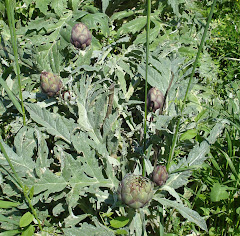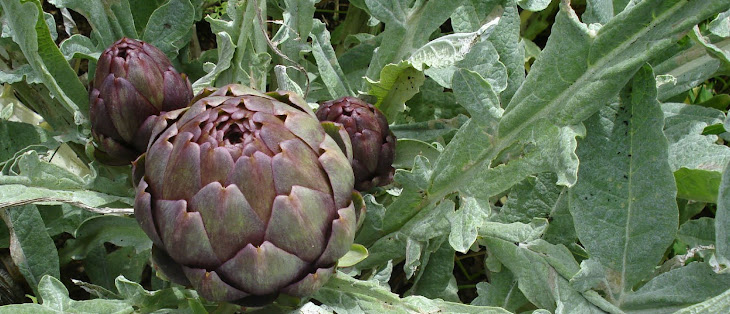
broom-covered hillside, with an almost overwhelming scent

The word 'garrigue' is a French word which comes from the Occitan 'garriga', land where only the oak - 'garric' - will grow. This is also said to link back to Celtic languages and the word for rock ('caer' in Welsh). Other parts of the Mediterranean have different names for the same vegetation - 'tomillares' (from the Spanish for thyme, 'tomillo', I suppose) in Spain, 'phrygana' in Greece, 'batha' in Palestine.
Areas of garrigue symbolise these rocky hillsides so much that you might think they were natural but in fact they are the result of human activity over thousands of years. From the time of the earliest settlements around the Mediterranean, people have cut down trees for firewood and cultivated the fruit trees and herbs which they found. Their sheep and goats have grazed the land for centuries, too. The loss of the forests has led to erosion of slopes leaving only the lower, hardier, less water-demanding plants which make up the garrigue.
The result is a mix of plants, most of which are evergreen: holm oak (evergreen oak), olivettes (small wild olive trees), broom, arbutus, rosemary, thyme and other herbs, and a colourful display of flowers in spring from asphodel, orchids and numerous small plants which grow wherever they find space.

asphodel

wild olive tree and cistus
Extensive fires have been in the news around the Mediterranean in recent years, in France, Greece, Portugal and elsewhere. These are frightening and dangerous, and often caused by people's carelessness (cigarette ends thrown from cars, picnic barbecues, and so on) and their colonising of previously wild areas, but some fire is also a natural part of the life-cycle of Mediterranean plants. Small areas of fire can be beneficial, clearing land for new growth. It is said here that the best places to find wild asparagus are where there have been fires in the past year or so.
Some other spring wild flowers:

wild gladiolus

thyme, cistus and Aphyllanthes monspeliensis

Galactites (I think)

honeysuckle
Flowers of the Mediterranean by Oleg Polunin and Anthony Huxley (Chatto and Windus, 1967) is the book I use for identifying Mediterranean plants - It's an excellent book with colour photos and good descriptions. I think there are newer editions and that it is still available.
There is a good article in French about the garrigue
here as well as other interesting nature articles about the Languedoc on the same website.
And a short article in English
here on the history of the garrigue.
And in autumn and winter ....

The arbutus bears its edible fruits at the same time as its flowers
(this picture was taken at the end of November)


 honeysuckle
honeysuckle













3 comments:
Lovely informative post chaiselongue (I might shorten your name to "c l" ??)Anyway I picked some of those arbutus (our common name for them is Irish Strawberry Tree) from my mother's garden last week and I have some photos to put on my blog when I get to it. They are quite nice to eat - a lot better than durian!
I enjoyed this thoroughly interesting post. You have a wonderful blog, packed with some great photos and information and I'm glad Blotanical has shown me the way to your lovely place. Keep up the excellent work.
P.S. Living in the Mediterranean area myself, I can relate to all the horrors of forest fires in this part of Europe, and it's really disheartening to see how far human greed can go, I mean, neglect is a fact of someone's upbringing but arson, that is beyond my comprehension. I just hope last year's tragedies will never happen again.
Take care and greetings from Croatia
People have had such a profound impact on the earth. It's amazing how much our actions shape the ecosystem around us. I enjoyed your photos of the plants of the garrigue.
Post a Comment